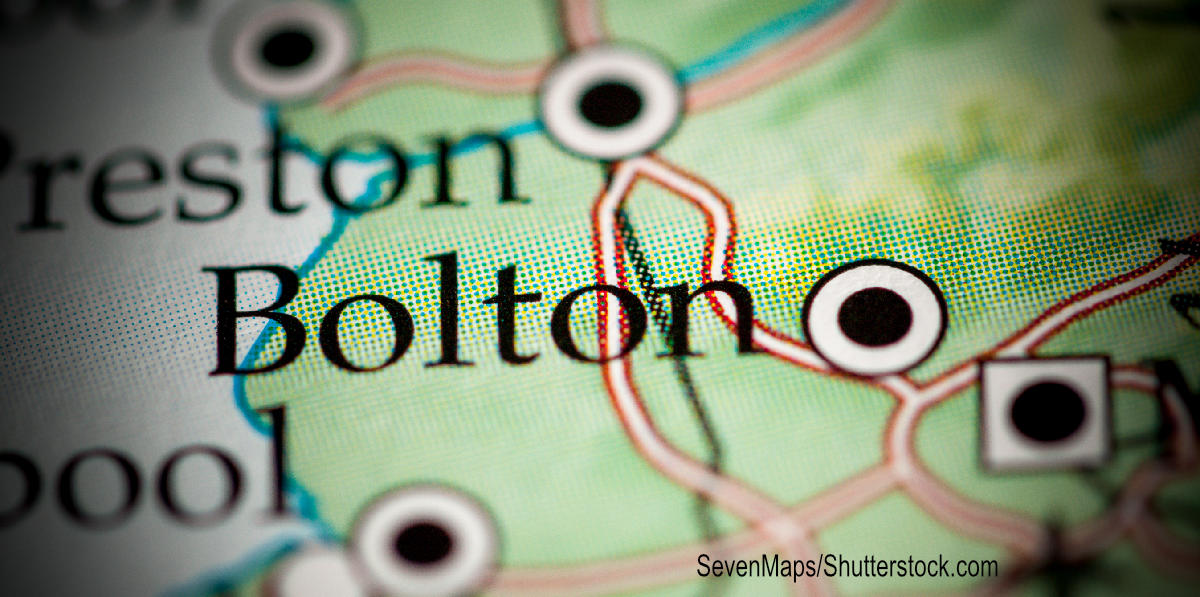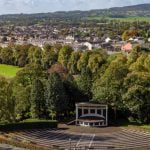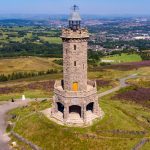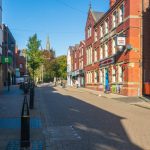
Bolton What started as a mill town shortly found a place in our hearts.
The people of Bolton are known for being kind, generous, and hard-working. Why? Well, that community spirit began when Flemish Weavers moved into the area in the 14th century… and it’s a tradition of friendliness that hasn’t left the area to this day!
We took a Five Minutes Spare glance at Bolton to find out what the best bits were. Let’s look back through time, first of all, to see how this lovely town sprang up, to begin with.
Bolton in the Beginning
Although exact records of the beginning of Bolton are hazy, we know that the name derives from the old English tongue. It would have stood for two separate words, the Bothl tun. This loosely means the living place with a home in it. The first physical recording of the town is in the Domesday book, which was written 20 years after the Norman invasion.
There has been evidence of historical settlements in town since back in the Bronze Age. They found stone circles in a nearby town, but the Bolton Moors have been the known location of bronze age burial mounds and even the Romans stopped here for a while. In fact, the Romans built a road connecting Manchester and Ribchester, cutting through Bolton. A fort was built at Blackrod, but the Romans haven’t been in England since around 100 AD…
Bolton is old.
In the Domesday book Bolton is recorded as belonging to a Norman nobleman named Roger de Poitou. It was recorded as being a small settlement in the hundreds of Morsely. The population wasn’t recorded, which is strange. This would only happen if the town was huge or if it was abandoned. The book records 8 ploughlands but no houses. Again, strange given the etymology of the name.
During the first of many English Civil Wars (the one just after Domesday was called ‘the Anarchy’), Bolton switched back to English hands. The Earls of Derby held the area until a charter was passed in the 13th century for them to hold a market. For a while, it was a market town – a tradition that continued right up into the 18th century, even though the goods they sold changed drastically. It was only shortly after this that those Flemish weavers we mentioned earlier settled in the town and the whole world changed!
Flemish Weavers
You might not believe that a few weavers could make a big difference in the town. However, when all we knew how to do here in Britain was dye and full out wool, but they drove the next steps in the process by showing us how to turn the dyed wool into cloth. Arguably, it was the progression of the cloths that tracked the progression of our advancement. Cotton followed wool, silk followed cotton, and by the time we had started inventing substitute fibres, it was the 20th century.
So Bolton became a cloth-making town. For the next couple of hundred years, they made cloth, dyed it, treated it, and sold it in their markets. Sea coal mining was a rather dangerous ulterior profession to the area. Once a year they had a fair, a week-long market where everyone would come to buy and sell, this continued until they started opening schools in the 14th century and Bolton Grammar was founded.
It wasn’t all plain sailing. During the 17th century the plague struck, then it struck again, and then a third time. The first was bubonic, the next was smallpox, the last is not noted but was presumably cholera. It would still take another hundred or so years before sewers were built. By the end of this century, it was known as a place full of fustians. Fustian was thicker, more weatherproof cloth that the second immigration of Flemish weavers taught.
Halfway through the 17th century, around 1642, a civil war broke out and Bolton found themselves on the wrong side of it. They supported Cromwell even though the rest of Lancashire didn’t. As a result, they were attacked and had to build some hasty defences. If you look carefully at the layout of the town nowadays you may still be able to see evidence of these. They were attacked in 1643 but repelled the invaders. In ’44 there was a repeat performance, but the Royalists finally took the town in May of that year.
It is estimated that as many as 1,000 soldiers died in the battles. However, we know that 3,000 parliamentarian soldiers were garrisoned here and that only 700 were taken, prisoner. That leaves a big gap in figures. So yes; we’re sorry to be the ones to break it to you, but if you live in Bolton you are probably living in a haunted town. It was forever remembered as the Bolton Massacre.
In a stunning twist of fate the son of Charles I tried to avenge his father but failed. His men were captured and among them was a man named the Earl of Derby. The powers-that-were dragged him to Bolton, where they chopped off his head in front of an angry crowd of locals. People back then were brutal.
Fun Facts About Bolton!
Let’s break up all this murder, death and gory detail with a little fun. We sourced some of the most interesting facts we could find about Bolton, to keep you amused during your break. Enjoy!
- Textiles were still made here up until WWI. Many of the uniforms worn by the soldiers would have featured materials made in the area. There were 216 cotton mills in Bolton in 1929[i].
- Bolton Wanderers are nicknamed ‘the Trotters’ reputedly because the original grounds were next door to a pig farm.
- With 260,000 people, Bolton is one of the biggest towns in Britain.
- The oldest pub in the county was first recorded – not even built, just recorded – in 1251. It’s not just the oldest in the county, it’s one of the oldest in England.
- The captain of the Titanic and the captain of the first ship that helped her when she sank – were both Bolton born[ii].
There! Now that we have breathed fresh life into your tired eyes with some interesting news, let’s get back to learning a little about Bolton. What happened to it after the 16th century and how did it turn into the cotton capital of Britain?
Bolton going into the Industrial Revolution
The Spinning Mule – a machine which helps turn the cotton plant into cotton threads – was invented in Bolton and first put to use here in the beginning of the 18th century. This is partially why cotton and wool working became so big here overnight. By 1773 the population was around 5,000 people. In 1780 Samuel Crompton opened the first cotton mill in Bolton… by 1850 -not even a hundred years later – the population was over 168k. That’s a hell of a leap.
At the start of the 19th-century paving, streetlights and even street cleaning were introduced to keep disease down. In 1824 a water supply was piped into the town, much to the relief of the locals. In 1814 the peasantry got their first medicinal dispensary, but the first hospital didn’t come until a little later.
Bleach was a huge thing in Bolton. Several businesses sprung up using the waters of the River Croal as their hydroelectric power source. Chlorine was added to bleaching just before the turn of the 19th century and was first introduced in this area. There were more than 30 of these types of businesses in the area. However, it was the cotton mills that built up the big business in Bolton. Some of the chimneys from that era are still in existence and lead to the sense of heavy industrialisation in the town – even now.
The Industrial Revolution did wonders for Bolton. It saw the introduction of a library, a market hall, a town hall, parks and a museum in Chadwick. The Preston railway brought more trade to the town. Electricity arrived at the turn of the 19th century. Iron mines and coal pits were opened… the population rose by a few hundred per cent and everyone thrived.
… Except the poor. Like many towns in England, the rapid growth of Industrial Bolton saw slums emerging. Whole families lived in single rooms in buildings built too close together. More recently we have the green belt policy to prevent too much of this, but huge efforts had to be made in the beginning of the 20th century to clear out the slums. New council housing was built before the war, but it did little to help. It wasn’t until the late 20’s that housing finally opened up in Bolton and people stopped living on top of one another.
Since the beginning of the 1900’s there have been loads of famous people out of Bolton. Let’s talk about who, what, and when they came to be.
Famous People from Bolton
Over the years, Bolton has seen its fair share of famous faces. Some of the Five Minutes Spare Favourites include:
- Amy Nuttal – that’s Chloe in Emmerdale to you and me, came from Bolton.
- The radio DJ Sara Cox is from here.
- Jay Fulton, pro footballer for Swansea, is from Bolton.
- Tom Parker, one of the bands ‘The Wanted’ is from Bolton[iii].
So there have been all sorts – from famous golfers to superstar inventors. Let’s finish up the history with a bit of Bolton through the wars. Why not? This hasn’t exactly been the cheeriest roundup we have ever done…
Bolton in the 20th Century
On September 26th of 1916, a zeppelin dropped 21 bombs on Bolton. While zeppelins were largely ineffective, this one managed to drop some of them on civilian areas. Still crowded after all that Industrial Revolution growth; the town suffered 13 deaths as a result. Incendiaries fell all over, narrowly missing the town hall, destroying houses and causing havoc.
After a major attempt at rebuilding and clearing slums in the 30’s, the Second World War hit. Bolton suffered another air raid. As an important industrial town, it was targeted – even although it was more likely to be making cloth than firearms. It must have looked pretty busy from the air. 11 people were killed in a single raid in 1941.
Further to the west, Manchester was bombed incessantly. It is possible that Bolton was mistakenly bombed as a suburb by off-course fighters. We know there were several air raids and that many of the locals were able to record their memories with local sources. You can read some of their heart-warming – but frightening – testimonies of Bolton during WWII over on Bolton’s War.
When the men of Bolton returned from the war they did so to a declining industry. Coal and iron went into decline and nobody wanted wool and cotton once polyester was a thing. There are still traces of bleach making around. We hate to think of how much environmental damage that would have done.
After the 60’s people had started to recover. Retail and leisure became industries in their own right. A cinema opened in ’67 followed by a shopping centre in ’71. Reebok Stadium didn’t arrive until 1997, but it wasn’t for want of trying. Nowadays Bolton still shows the remnants of the industrial era. Almost everywhere you look there is a cobbled street, a factory or a chimney. There are industrial areas aplenty – but they are quickly being swallowed by residential and retail areas.
The future for Bolton? We’re not sure. We do know that bleach is dead, and nobody spins cotton anymore. Maybe the fabrics of the future will be invented here? We guess only time will tell.
Attractions in Bolton
There are loads of things to do in Bolton if you are here for a holiday. We found some of our favourites to make your itinerary flow smoothly. Have fun exploring!
Historical Sights and Landmarks
Bolton is full of ghosts, whether literal or figurative. Check out Turton Tower for a haunted landmark. Built-in the 1400s, this family tower house is a listed building filled with fine furnishings, decorative art, and furniture made in the local area. It’s been so lovingly kept it is worth a visit even if you don’t love ghost stories, but if you do then take your camera. This ghost has been known to make a ghastly movie appearance.
If ancient towers don’t ring your bell then Horwich Heritage Centre might. For those with connections or roots in the area, this place is a diamond in the rough. It is filled with old photos of Bolton. There is a high chance you will spot a grandparent or ancestor among their files.
Bolton is also home to a number of different statues. You could entertain the kids for a few hours trying to track some down. What about finding The Samuel Taylor Chadwick or the Benjamin Alfred Dobson statues? Might kill a few hours in Bolton in an educational way…
Museums and Galleries
The Bolton Steam Museum is one of the busiest in towns. It is home to the Northern Mill Engine Society Collection, among other steam engine inspired exhibits. It really is fascinating to look into early inventions with moving parts; especially in the town that had more than 200 mills.
Bolton is also home to Samuel Compton’s house. If you remember back a few hundred years, he was the one that invented the spinning mule. Someone restored and/or preserved his home and now you can visit it. It’s a stunning black and white building with some beautiful interiors. It’s called the Hall I’ th’ Wood, and it’s exactly as charming and delightful as it sounds.
The best collection of fine art in town can be found at the Bolton Museum and Art Gallery. There are other venues in town for those that want to buy pieces of their own, but everyone can visit the museum. Lastly, Smithills Hall Museum combines old house with artefacts and history, which makes a nice few hours out.
Nature and outdoor sights
If you are in Bolton and are looking for something to do with the kids, then check in at Smithills Open Farm. This place has a little petting zoo with baby animals to feed. There are little lambs and adorable goats and tiny. Itsy-bitsy cows… you can feed them or pet them or play with them… We don’t have kids, but if you need us, we will be petting the tiny little animals…
If you are looking for free places to spend an afternoon then take a lead from the locals and head out to Jumbles Reservoir. It is surrounded by its very own park where you can picnic, play, and generally enjoy some sunshine on a fine summer day.
Shopping and Retail
The Vaults is one of the best-known shopping centres in town. Also sometimes referred to as Bolton Market Place, this centre is inside the original 1800’s indoor marketplace building. There’s a cinema and plenty of places to eat. They are trying to make it the heart of the town’s social scene so if you want a party it’s a good place to start.
If the Vaults doesn’t have what you are looking for, head to the Middlebrook Retail and Leisure Park. It has the selection of shops you have been missing in your life. The truth is that the town centre is packed with great shopping areas. Just have a wander and you will reach what you need in the end.
Where to Eat, Drink and Party in Bolton?
If you happen to be looking for some serious fine dining, check out Nick’s Restaurant. It mixes British cuisine with AAA+ dining to bring the best foodie experience around town. If you want to pair those high-end taste buds of yours with some of the best wines in town, the Northern is the restaurant for you. If you are feeding kids, then Casalingo is a good shout. Most kids like Italian… Right?
If wine is less likely than whisky or beer, you can get a stiff pint at the White Horse Inn. For cocktails then the Kahiki Hideout is your best bet. It’s a nice taste of the tropical in sunny old England… Level is the most frequented club in town if you like popular DJs and dancing all night… Do people still do that?
Other Notable Attractions
There are multiple things to do in Bolton that we couldn’t fit into one place. If you are staying for any length of time, here are some of the other things you should think about seeing:
- Moses Gate Country Park – there are actually a fair few parks for you to hang out in around Bolton. This one is lovely in Summer and comes with ducks.
- Horwich Leisure Centre – if you are trying to entertain kids in Bolton on a Saturday afternoon then head to the swimming pool.
- Party and Play Funhouse – they have a brilliant picnic area and even an adventure playground for kiddies.
There are plenty of sights to keep you occupied on holiday in Bolton. Let loose and enjoy yourself.
How to Get There
How do you get to Bolton? We found out, don’t panic.
By Road
Find your way to Manchester then head north on the M66, then west on the A58. From the north head south on the M61 until you see the turnoff.
By Rail
Get the train to Manchester – or even head to Blackpool – then get the train to Bolton Railway Station.
By Air
Again, Manchester is your closest bet. It will be about an hour away so make time.
By Sea
There’s no sea access to Bolton. The River Croal still runs through it though.
Got Five Minutes?
Did you have a little chuckle to yourself in between the massacres in this article? If so, we have a whole host of other local guides to tickle your funny bones. Check out our travel section and start planning your next trip, all with a little help from the team at Five Minutes Spare.
[i] https://factfile.org/10-facts-about-bolton
[ii] https://blog.gumtree.com/gumtrees-fun-facts-about-bolton/
[iii] https://www.ranker.com/list/famous-people-from-bolton/reference




